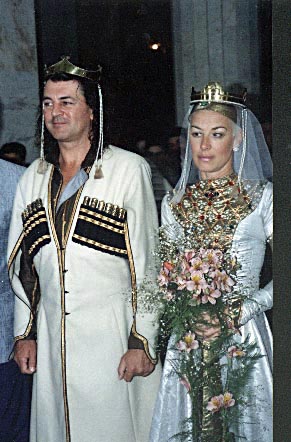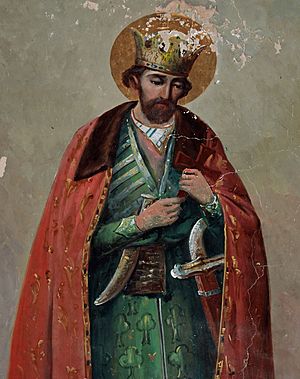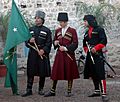Chokha facts for kids
The chokha is a special traditional outfit for men. It comes from the Caucasus region, a mountainous area between Europe and Asia.
Contents
What is the Chokha's History?
The chokha has been worn by Georgians for a very long time. People started wearing it around the 800s. It was popular until the 1920s.
Today, the chokha is still very important in Georgia. It shows how proud Georgians are of their country. This special wool coat has a high neck. Georgians wore it for over a thousand years. But during the time of Soviet rule, it was not seen very often. Now, many people wear the chokha again. It reminds them of Georgia's strong history. It also shows their country's fight for freedom.
How the Chokha Became Popular Again
A former Georgian President, Mikheil Saakashvili, wanted to bring the chokha back. He asked important Georgian officials to wear it. These officials wore the chokha at official meetings. This happened even when they were working in other countries.
So, in Europe today, you might see men in chokhas. They stand out among people wearing regular suits. They often wear a small dagger at their waist too. This shows their national pride.
Different Kinds of Chokha

There are four main types of chokha:
- Kartl-Kakheti chokha: This type is from eastern Georgian areas. These areas are called Kartli and Kakheti.
- Khevsur Chokha: This one is mostly found in the Mtskheta-Mtianeti area of Georgia.
- Adjarian chokha: This type is common in western Georgia. Areas like Adjara and Guria use it. It was also worn in Lazona, which is now part of Turkey.
- General Caucasian chokha: This looks a lot like the Kartl-Kakheti chokha. The main difference is that it is a bit longer.
The "Order of Chokhosani"
In Georgia, the black chokha was very special. It was worn by members of the "Order of Chokhosani". This group was made up of the most respected people in society.
These were people who had done great things for their country. They included famous generals, heroes, or well-known poets. Even some lords were not allowed to join this special order. Those who were part of it wore their black chokha with great pride.
What Does a Chokha Outfit Include?
The chokha is made from thick fabric. It fits tightly around the waist. But it is wide at the bottom. In some parts of the Caucasus, women also wear chokhas.
A full chokha outfit usually has several parts:
- Khanjali: This is a type of sword.
- Akhalukhi: This is a shirt worn underneath the chokha.
- Masrebi: These are decorative pockets for bullets. They are often seen on the chest.
- Kabalakhi: This is a hood that is separate from the main robe.
- Nabdis kudi: This is a tall fur hat. It can be worn instead of the kabalakhi.
Images for kids
-
A caftan worn by a horseman along the Silk Road, 8th–10th century AD. The wearer could have been a man from Alania, in a region then under Khazar domination. Metropolitan Museum of Art.
-
Sogdian soldier.
-
Georgian cavalry wearing a Kartli-Kakheti chokha
-
A Tatar Bek (Azerbaijani) from Karabakh. (artist - Gagarin GG)
See also
 In Spanish: Choja para niños
In Spanish: Choja para niños


















